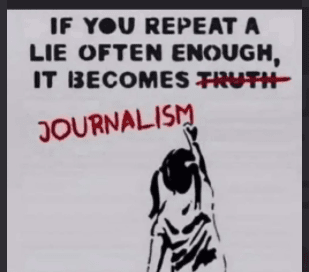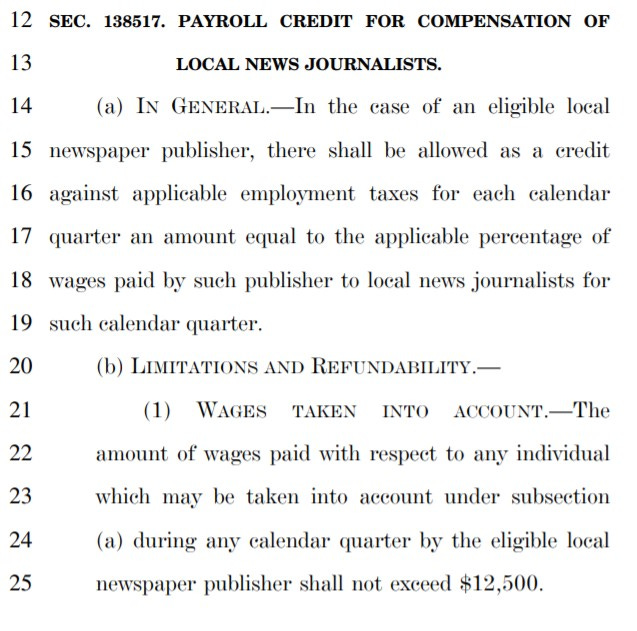Journalism Bailout in $3.5 Trillion Budget Bill
Worried About Declining Newsroom Employment, Congress is Poised to Subsidize Them. How Will It Promote Real "Journalism?"
It’s not news that traditional newsrooms are shrinking across America. Some local newspapers have gone from daily to biweekly or less, if not out of business altogether. This, despite the rise of new digital news organizations in recent years. You’ve probably seen them, from a national network of local “Patch” outlets, left-leaning Axios and its new bevy of locally-focused affiliates, to the center-right JustTheNews.com.
It is also not news to know why - the rise of digital media via “big tech.” A Pew Research Center study from January claims that 86% percent of us now get our news from “digital devices,” like our smartphones and tablets.
It is also not news that most Americans - except most Democrats - think the news industry is biased, even corrupt. An August Gallup and Knight Foundation survey shows that “Three in four people (70%) worry that owners of media companies are influencing coverage. They also suspect that inaccuracies in reporting are purposeful, with 52% believing that reporters misrepresent the facts, and 28% believing reporters make them up entirely.”
But don’t worry! Joe Biden and Congressional Democrats are coming to the rescue.
On Saturday, the House Budget Committee passed a budget reconciliation bill, Senate Concurrent Resolution 14, the so-called Build Back Better Act. It provides a payroll tax credit for the compensation of “local” journalists. You can find it on page 2326 of the bill. Here’s how the provision starts.
Remember, this is a credit for taxes owed, not a new deduction. And it allows a local or regional newsgathering entity (digital or otherwise) a credit against federal taxes of up to $50,000 per year per journalist. That makes it a generous federal tax subsidy. You know, the kind of tax subsidy that many in Congress and the media decry when they benefit other industries.
Interestingly, you will find very little coverage or information about that tax subsidy in almost any major news outlet. Not the Washington Post (which probably is too big to qualify for it, anyway). Certainly not left-leaning Politico, which perhaps does qualify for the subsidy. I’ve only found two newspapers thus far that support the original bipartisan legislation that proposed it, the left-leaning Philadelphia Inquirer today and the Everett Herald Net from Washington State, both in the form of editorials. And, of course, the legacy newsgathering industry is all behind it.
The Inquirer editorial claims that the bill is “friendly” to the First Amendment.
Fortunately, there is a thoughtful way to help local news without government control. It’s called the Local Journalism Sustainability Act – and it has a real chance to become law, especially if championed by the Pennsylvania delegation. Now under consideration by Congress, this bipartisan bill provides more help for local news than any legislation in the last century – all accomplished in a decidedly First Amendment-friendly way.
Maybe that’s why we’re simply not seeing any coverage that is remotely negative about the “Build Back Better Act” in the Inquirer or most any media outlet, especially since they may stand to benefit handsomely from this provision. The media, it seems, is not interested in biting the hand that is about to feed it.
What was that about “government control” again?
The original legislation goes farther than the reconciliation bill. It includes a tax subsidy for local advertisers up to $5,000. And it doesn’t go as quite as far as Canada’s media subsidies or the new “digital news subscription tax credit” of up to $75 to individual subscribers.
It is worse than that in Canada. In November 2018, Canadian freelance journalist Jen Gerson wrote this in a Washington Post oped about Canada’s new journalism laws. It provides a roadmap for the United States.
(Canada’s Liberal government) announced a $595 package to be offered over five years. Eligible media will get a suite of goodies, including a labor tax credit. Nonprofit media will be able to attain charity status that will give them the right to issue tax receipts to donors. And the government will offer a 15 percent tax credit for subscriptions.
The latter two proposals seem rather reasonable. The bailout does, however, raise a serious existential concern: Who decides which media organizations qualify?
For that, a pat answer: The government will consult an independent panel of journalists to decide which outlets meet the “professional” standards required. The ultimate goal, according to the Finance Minister Bill Morneau, is to “protect the vital role that independent news media play in our democracy and in our communities.”
“The plan was greeted with joy among every media executive,” Gerson continued. “Those of us further down the totem pole have since been left to ponder the fresh horror we have brought on ourselves.”
While Gerson’s comments deal with a “professional credentialing” system to decide who should receive subsidies, who doesn’t see this coming to the US as America’s new bailout for journalists is rolled out? When the first “controversial” recipient of a journalism tax credit becomes known, the pressure from the traditional newsgathering industry to lobby for tighter standards will ensue with a vengeance.
No doubt, the provision’s authors think they include a fail-safe set of guardrails to make sure the money goes where it is intended, “local newspapers” and “local journalists.” For example:
Let’s also look at the definition of a “local newspaper.”
The term ‘‘local newspaper’’ means any print or digital publication if
(A) the primary content of such publication is original content derived from primary sources and relating to news and current events,
(B) such publication primarily serves the needs of a regional or local community,
(C) the publisher of such publication employs at least one local news journalist who resides in such regional or local community, and
(D) the publisher of such publication employs no more than 750 employees during the calendar quarter with respect to which a credit is allowed under this section.
Nice try, but I can already see some interesting opportunities for people and organizations looking to win a tax subsidy to peddle their version of “local” journalism. If I were the head of a devious political advocacy organization, I’d be salivating at this opportunity. Let’s start with the fact that “local” and “regional” are not defined. Or what qualifies as “matters of local public interest.”
That’s when the traditional “local” media, whose failure or inability to compete for local advertising revenue and subscribers is leading to this subsidy, will jump in. They will advocate for stricter standards of what it means to be a “journalist” or a “local” news entity. Or what qualifies as “matters of local interest.” I guess the legacy media industry is too big to fail. Protectionism is back, baby.
“Government’s view of the economy could be summed up in a few short phrases: If it moves, tax it. If it keeps moving, regulate it. And if it stops moving, subsidize it.” — Ronald Reagan
I feel the same way about this journalism bailout as Gerson did about Canada’s.
How this system is expected to strengthen press freedom, I have no idea. From what I can see, it will only lead to a national professional standard or credential that will inevitably centralize control over the media in a country where the media is already profoundly consolidated.
I worked through college and began my professional career as a local journalist and state capitol correspondent in Oklahoma. Driving last year by the now-former offices of the Henryetta Free-Lance (no longer a daily, and they’ve moved down the street to smaller quarters, sans offset newsprint presses), its long-abandoned facade haunted me.
Local journalism matters. But small-town local journalism’s fate is often tied to local demographics and the economy. Many of the once-thriving local downtown businesses in Henryetta are long gone. At least the local glass manufacturing plant appears to be operating. Henryetta’s population has declined over the past 40 years, despite its advantageous location at the intersection of US 75 and I-40, between Fort Smith, Arkansas, and Oklahoma City, with plenty of water, cheap land, and a very low cost of living.
The journalism bailout probably isn’t going to help the Henryetta Free-Lance very much. But more prominent city newspapers such as The Daily Oklahoman and Tulsa World will quite likely benefit. So will a growing cottage industry of nationally-consolidated “local” journalism outfits, as we see at Axios and Patch. And even a new cottage industry of activist journalism. At your expense, of course.
Democrats remain in disarray over their $3.5 trillion reconciliation bill, crafted without Republican input or support. Its prospects in the full House and Senate remain in doubt, and its final provisions remain a mystery. Maybe the journalism bailout, if it survives, will revive real local journalism. We’ll see, but count me as skeptical. Very skeptical. Once the media cracks opens the door to accept government tax subsides, journalism licenses can’t be far behind.






